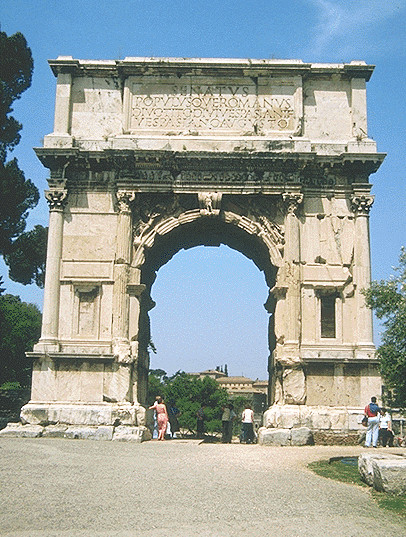Triumphal Arches
ROMAN ORIGIN AND USAGE
Definition
A triumphal arch is a commemorative monument in the form of a single arch or a trio of arches of which the central one is larger than the outer two.
Origin
Triumphal arches originated with the Roman practice of building temporary arched structures for festivals in the second century BC. By the end of the next century, arches were erected in stone as permanent monuments.
Purpose
Triumphal arches generally honored emperors and commemorated achievements such as military victories like Constantine's defeat of Maxentius at the Milvian Bridge or civic projects like Trajan's building of the Via Traiana in Benevento.
Many of the triumphal arches erected in the provinces commemorated visits by Roman emperors.
Inscriptions
Inscriptions, which were usually placed on attic stories, noted the contributions of the emperors responsible for the achievements. Mention was often made of their divinity and important relatives. The dedication of the Arch of Titus, for instance, includes a reference to Titus' father, Vespasian, who was emperor when Titus sacked the city of Jerusalem, the event commemorated.
Bronze, which has long since been removed, was placed within the incised letters to make the inscription stand out.
Placement
As commemorative monuments, triumphal arches could be arbitrarily placed on civic sites or across roadways. In Rome, three triumphal arches straddled the main procession route through the forum.
ORNAMENTATION
The Orders
Initially, pilasters or engaged columns flanked the arched openings.
After being introduced on the Arch of Septimius Severus at the beginning of the third century AD, free-standing columns became standard for the decoration of triumphal arches in Rome.
Division into Stories
The main story, located between a pedestal base and an attic story, was comprised of columns carrying an entablature.
Relief Sculpture
Relief sculpture usually ornamented the arch's fronts and sides as well as the intrados (inner facing) of the barrel vault, which could be seen while passing through the structure.
The subjects of the reliefs were related to the persons or events being commemorated.
Victories or reclining river gods often filled the triangular shapes of the spandrels.
Bronze Sculpture
Triumphal arches were originally crowned by cast bronze effigies depicting the honoree in a chariot pulled by horses or elephants. A quadriga refers to both the chariot and the group.
Unfortunately, the quadrigas made for triumphal arches have long-since been melted down, but an idea of the horses can be visualized from the four bronze horses decorating San Marco in Venice. They are commonly believed to be late Roman copies of Greek originals that had been brought to Constantinople by the late Roman emperor Theodosius II (408-450), who had them set up in the city's hippodrome as a quadriga. Reproductions now stand outside the cathedral, and the originals are displayed in the Marciano Museum.
INFLUENCE ON LATER ARCHITECTURE
Renaissance
In the fifteenth century, Alberti based several of his church façades on the triumphal-arch form.
In the sixteenth century, Sanmicheli and Sansovino patterned gateways, entrances, and loggias after the triumphal-arch form.
By the middle of the sixteenth century, arched triadic compositions that echoed triumphal arches emphasized the central zones of many façades.
Neoclassical Period
In the Neoclassical period, which began in the second half of the eighteenth century, triumphal arches were replicated and dedicated to contemporary leaders and events. A number were commissioned by Napoleon.
Modern Period
In the twentieth century, the Finnish-American architect Eero Saarinen re-created the triumphal arch in a modern idiom and on an unprecedented scale in St. Louis with the Gateway Arch (1948-68).
EXAMPLES OF TRIUMPHAL ARCHES
Number to Survive
Although eroded by time, their blockish shape and solidity has favored the survival of triumphal arches, and about 125 have survived.
Examples
Many of the surviving monuments lie in cities around the Mediterranean.
♦ Arch of Augustus, Rimini, 27 BC
♦ Arch of Augustus, Rome, 19 BC
♦ Arch of Tiberius, Orange, France, AD 21
♦ Arch of Titus, Rome, AD 81
♦ Arch of Trajan, Benevento, AD 114
♦ Arch of Septimius Severus, Rome, AD 203
♦ Arch of Constantine, Rome, AD 315

Arch of Titus, Rome, AD 81



 Add Placemark
Add Placemark Go Back
Go Back 




